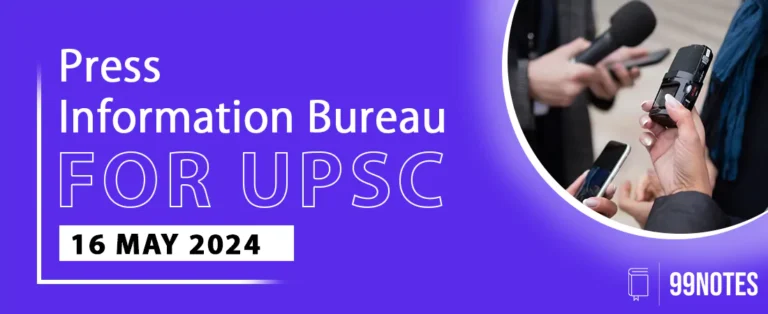22 June 2024 : PIB Summary For UPSC
- India’s pursuit for Aatmanirbharta in Defence crucial for achieving Strategic Independence: CDS
(Source – https://pib.gov.in/PressReleseDetail.aspx?PRID=2027734 )
|
Topic: GS3 – Internal Security |
|
Context |
|
● Gen Anil Chauhan, Chief of Defence Staff, inaugurated the first Armed Forces BEML Synergy Meet 2024 in New Delhi, emphasising India’s commitment to defence indigenisation and self-reliance. ● The event aimed to foster collaboration between BEML and the armed forces for advanced defence solutions. |
Analysis of the news:
- Gen Anil Chauhan, Chief of Defence Staff, inaugurated the maiden Armed Forces BEML Synergy Meet 2024 in New Delhi, emphasising India’s pursuit of defence indigenisation and self-reliance.
- The event aimed to deepen collaboration between BEML and the armed forces to deliver cutting-edge solutions for future military needs.
- Gen Chauhan highlighted the concept of Aatmnirbharta in defence, aiming for autonomy in defence production and positioning India as a global defence exporter.
- He commended BEML for its contributions and stressed the importance of joint integration to achieve synergy in military modernization.
|
Defence indigenisation and self-reliance: |
|
Importance: ● Strategic Independence: Reduces dependency on foreign nations for critical defence equipment and technology. ● Enhanced Security: Ensures availability of reliable defence systems during times of geopolitical tensions or embargoes. ● Technological Advancement: Promotes innovation and development of cutting-edge technologies within the country. ● Economic Growth: Boosts domestic manufacturing and creates employment opportunities in the defence sector. ● Cost Efficiency: Reduces long-term costs associated with imports and maintenance of foreign-origin equipment. ● National Pride: Fosters national pride and sovereignty by showcasing indigenous technological capabilities. Challenges: ● Technological Gap: Initial lack of advanced technology and expertise compared to global leaders. ● Infrastructure Limitations: Insufficient infrastructure and facilities for research, development, and testing. ● Funding Constraints: Limited budget allocations and funding for research and development in defence technologies. ● Regulatory Framework: Complex regulatory processes and bureaucratic hurdles in defence procurement and production. ● Skill Development: Shortage of skilled workforce and technical expertise in niche areas of defence manufacturing. ● Risk Aversion: Reluctance among stakeholders to adopt indigenous technologies due to perceived risks and uncertainties. |
|
PYQ: Foreign direct investment in the defence sector is now said to be liberalised. What influence is this expected to have on Indian defence and economy in the short and long run? (200 words/12.5m) (UPSC CSE (M) GS-3 2014) |
|
Practice Question: Discuss the significance of defence indigenisation and self-reliance for India’s national security and economic growth. What are the key challenges hindering progress in achieving these objectives? (250 Words /15 marks) |
- Yoga has become a unifying force, bringing together people across cultures and backgrounds: PM
(Source – https://pib.gov.in/PressReleseDetail.aspx?PRID=2027805 )
|
Topic: GS2 – Governance |
|
Context |
|
● Prime Minister Narendra Modi praised the global observance of the 10th International Yoga Day, noting widespread participation and the unifying impact of Yoga across cultures. ● He expressed gratitude to those promoting Yoga and highlighted its increasing popularity among youth and instructors. |
Analysis of the news:
- Prime Minister Narendra Modi praised the widespread participation in the 10th International Yoga Day, acknowledging the collective efforts of individuals, communities, and organisations worldwide.
- He highlighted Yoga’s role as a unifying force transcending cultural and background differences, particularly noting enthusiastic youth involvement.
- The Prime Minister expressed gratitude towards those promoting Yoga, emphasising its potential to enhance unity and harmony globally.
- Modi commended the growing number of Yoga instructors whose dedication motivates others to embrace Yoga.
- He concluded with a hopeful message for Yoga to continue fostering global unity in the future.
|
International Yoga Day: |
|
● International Yoga Day is observed annually on June 21 since its inception in 2015, following a UN declaration initiated by Prime Minister Narendra Modi. ● The day aims to raise awareness about the benefits of Yoga, an ancient Indian practice promoting physical, mental, and spiritual well-being. ● It serves as a platform to highlight Yoga’s role in achieving global health and harmony. ● Celebrations include mass Yoga sessions, workshops, seminars, and cultural performances worldwide. ● The theme for International Yoga Day varies each year, focusing on specific aspects of Yoga’s holistic benefits. ● In 2024, the 10th International Yoga Day saw widespread participation globally, emphasising Yoga as a unifying force transcending cultural and geographical boundaries. ● The day underscores India’s cultural heritage and its contributions to global wellness practices. ● Institutions, governments, and communities organise events to promote Yoga’s practice and encourage its integration into daily life for holistic health benefits. |
|
Practice Question: Discuss the role of Yoga in enhancing India’s soft power on the global stage. How has the international promotion of Yoga contributed to India’s cultural diplomacy and influence? (150 Words /10 marks) |




